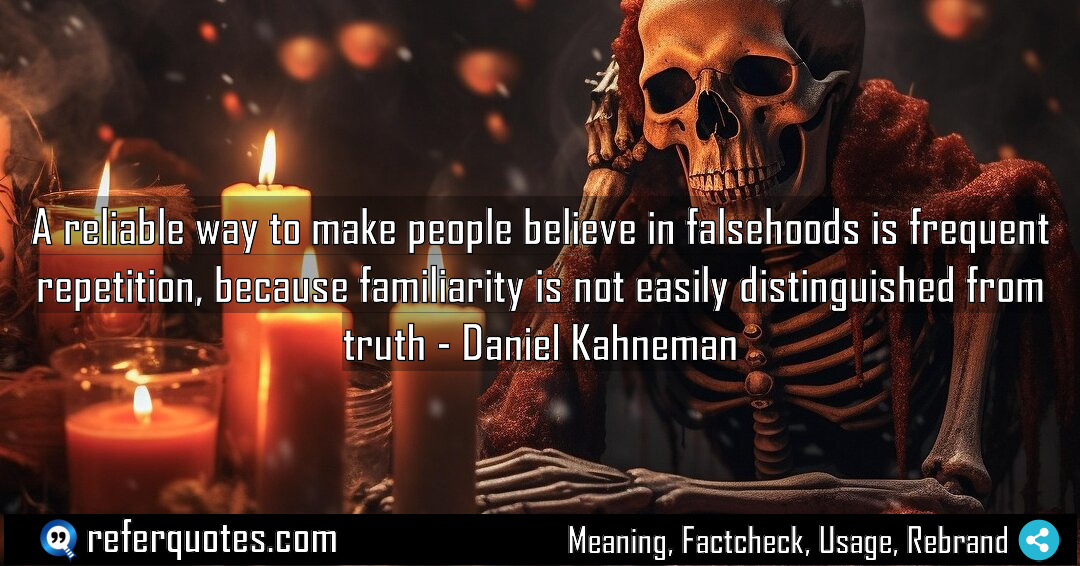A reliable way to make people believe in falsehoods… it’s a chilling thought, right? But Daniel Kahneman nailed a fundamental flaw in our mental wiring. We’re not rational logic machines; we’re creatures of habit and familiarity. And our brains often confuse the two.
Share Image Quote:Table of Contents
Meaning
At its core, this quote means that the more we hear something, the more likely we are to accept it as true, regardless of its actual validity. It’s about the sheer power of exposure.
Explanation
Let me break this down the way I see it after years in marketing and psychology. Your brain has two systems. System 1 is fast, intuitive, and lazy—it loves shortcuts. System 2 is slow, analytical, and effortful. Now, repetition is like jet fuel for System 1. It creates a feeling of fluency. Something that’s easy to process feels familiar, and something familiar feels… safe, comfortable, and true. It’s a cognitive glitch. We mistake the ease of recognition for the marker of truth. That’s why a catchy slogan or a persistent rumor can feel more real than a complex, factual report. The brain just goes, “Hey, I’ve heard this before, must be legit,” and moves on to save energy.
Quote Summary
| Context | Attributes |
|---|---|
| Original Language | English (3668) |
| Category | Education (260) |
| Topics | perception (39), repetition (5), truth (77) |
| Literary Style | didactic (370) |
| Emotion / Mood | serious (155) |
| Overall Quote Score | 81 (258) |
Origin & Factcheck
This insight comes straight from Daniel Kahneman’s 2011 magnum opus, “Thinking, Fast and Slow,” which synthesized decades of his research with Amos Tversky. It originated from their work in cognitive psychology, primarily in the US and Israel. You sometimes see this idea attributed to others, like Joseph Goebbels and his “big lie” theory, but Kahneman’s point is different and scientifically grounded. It’s not about the size of the lie, but the relentless frequency of its repetition, which exploits a universal, apolitical bug in human cognition.
Attribution Summary
| Context | Attributes |
|---|---|
| Author | Daniel Kahneman (54) |
| Source Type | Book (4032) |
| Source/Book Name | Thinking, Fast and Slow (54) |
| Origin Timeperiod | 21st Century (1892) |
| Original Language | English (3668) |
| Authenticity | Verified (4032) |
Author Bio
Dr Daniel Kahneman transformed how we think about thinking. Trained in Israel and at UC Berkeley, he built a career spanning Hebrew University, UBC, UC Berkeley, and Princeton. His partnership with Amos Tversky produced prospect theory and the heuristics-and-biases program, culminating in the Nobel Prize in Economic Sciences. He engaged broad audiences through bestselling books and practical frameworks for better decisions. He continued writing and advising late into life, leaving ideas that shape economics, policy, medicine, and management. If you want to dive deeper, start with the Dr Daniel Kahneman book list and explore his enduring insights.
| Official Website
Where is this quotation located?
| Quotation | A reliable way to make people believe in falsehoods is frequent repetition, because familiarity is not easily distinguished from truth |
| Book Details | Publication Year: 2011; ISBN: 9780374275631; Latest Edition: Farrar, Straus and Giroux, 2013; Number of pages: 499. |
| Where is it? | Part II: Heuristics and Biases, Chapter 13: Availability, Approximate page 221 (2013 edition) |
